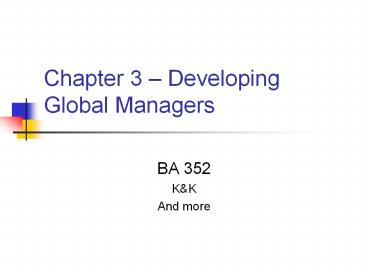Chapter 3 - PowerPoint PPT Presentation
1 / 17
Title: Chapter 3
1
Chapter 3 Developing Global Managers
- BA 352
- KK
- And more
2
Key Questions
- What is culture?
- How do cultures differ across countries?
- Why do we need to worry about other cultures?
- How does national culture impact behavior in
organizations? - What difficulties arise when transferring
management practices across cultures?
3
Culture
- the collective programming of the mind.
- Hofstede, G.1984.Cultures consequences
International differences in work-related values
(abridged ed.). Beverly Hills, CA Sage. p. 13
4
Cultural competence
- The ability to act appropriately with people of
different cultures while minimizing culture shock
for yourself and others
5
Dimensions of Culture - Hall
- Language
- Low Context Cultures
- Things are fully spelled out words are
important. - High Context Cultures
- More implicit communication assume commonality
of knowledge and views. Meaning based on context
- body language, setting, relationships - (Schermerhorn, Hunt, Osborn, 1998)
6
Context
Switzerland Germany Scandinavia United
States France England Italy Spain Greece Arab
Countries Chinese Japanese
LOW context HIGH context
Samovar Porter, 1991
7
Time Orientation
- Polychronic Cultures
- View time as flexible and multidimensional
- Monochronic Cultures
- View time as limited, precisely segmented and
schedule driven
Kinicki Kreitner, 2003
8
Other Dimensions - Hall
- Use of Space
- personal bubbles of space
- architecture
- Office spaces
- Town layouts
- Religion
- personal rituals, holy days, allowable foods and
beverages, morals and values - (Schermerhorn, Hunt, Osborn, 1998)
9
Values Cultures - Hofstede
- Large cross-cultural research project
- Between 1967 - 1973 over 100,000 employees of IBM
in 49 different countries - Surveyed about preferences in work related values
- Resulted in 4 value dimensions (later expanded to
5) - (Hofstede,G., 2001)
10
Power distance
- the extent to which the less powerful
membersaccept and expect that power is
distributed unequally. - (Hofstede, 2001, p 3.)
Lowest Austria 11
U.S. 40 Highest Malaysia 104
11
Individualism - Collectivism
- the tendency of a culture to emphasize individual
or self-interests versus collective or group
interests. - (Hofstede, 2001, p 3.)
Lowest Guatemala 6 Highest U.S 91
12
Uncertainty Avoidance
- a societys tolerance for uncertainty and
ambiguity. - (Hofstede, 2001, p 3.)
Lowest Singapore 8 U.S 46 Highest Greece 112
13
Masculinity-feminity
- distribution of roles between the genders.
(Hofstede, p.3) - tendency of a culture to value assertiveness and
acquisition of money and things vs. concern
with relationships, others and the overall
quality of life (Adler, 2002, p. 61)
Lowest Sweden 5 U.S 62 Highest Japan 95
14
Long term Short term Orientation
- The tendency of a culture to emphasize values
associated with the future vs devotion to work
ethic and tradition. (Adler, 2002, p. 63)
Lowest West Africa 16 U.S 29 Highest China, mainland 118 Taiwan 87
15
U.S. culture
- Individualism
- Equality
- Materialism
- Science and technology
- Progress and change
- Work and leisure
- Competition
- Adapted from Samovar Porter, 2001
16
Developing a global mindset
- An openness and awareness of diversity across
cultures with a tendency and ability to
synthesize across this diversity. - Gupta Govindarajan (2002). Cultivating a global
mindset, Academy of Management Executive.
17
Works cited
- Adler, N. (2002). International dimensions of
organizational behavior. (4th ed.). Cincinnati
South-western. - Gupta Govindarajan (2002). Cultivating a global
mindset, Academy of Management Executive. - Hofstede, Geert (2001). A Summary of my ideas
about national cuclture differences.
http//spitswww.uvt.nl/web/iric/hofsteded/page3.ht
m 4/6/2004 - Hofstede, Geert (2001). Cultures consequences,
Comparing values, behaviors, institutions and
organisations across nations. (2nd ed.). Thousand
Oaks, CA Sage. - Kinicki, A. Kreitner, R. (2003). Organizational
behavior Key concepts, skills best practices.
Boston McGraw-Hill. - Samovar, L.S. Porter, R.E. (2001).
Communication between cultures (4th ed.).
Belmont, CA Wadsworth. - Samovar, L.a. Porter, R.E. (1991).
Intercultural communication A reader. (6th ed.).
Belmont, CA Wadsworth. - Schermerhorn, J.R. Hunt, J.G., Osborn, R.N.
(1998) Basic organizational behavior (2nd ed.).
NY Wiley.































